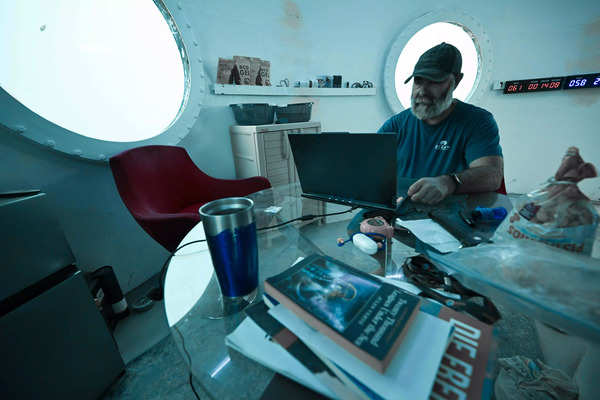A German aerospace engineer has chosen an extraordinary mission to set a world record by living in a submersible capsule 11 meters (36 feet) beneath the sea off Panama’s coast.
Rudiger Koch, 59, has already spent two months underwater and has two more months to go. His ambitions extend beyond record-setting. He believes this experiment as a way to transform our understanding of human existence and the possibilities of where we can live—potentially even permanently.
“The last time I checked, I was still married,” he told news agency AFP, as fish glided through the vibrant blue Caribbean waters visible outside the capsule’s portholes.
“What we are trying to do here is prove that the seas are actually a viable environment for human expansion,” he said, adding that, “Moving out to the ocean is something we should do as a species.”
- His underwater capsule, spanning 30 square metres has essential modern amenities: a bed, toilet, TV, computer with internet access, and an exercise bicycle.
- On a small bedside table rests Jules Verne’s Twenty Thousand Leagues Under the Sea, a 19th-century science fiction classic.
- Inside the capsule, two clocks mark the time passed and the countdown to his return.
- The only thing missing in the submerged residence is a shower facility.
- A narrow spiral staircase connects to the chamber above, all situated about 15 minutes by boat from Puerto Lindo, off northern Panama.
- Four cameras monitor Koch’s movements, documenting his daily life, tracking his mental health, and verifying that he hasn’t surfaced.
- Israeli technician Eial Berja oversees the cameras, manages the electricity, and maintains the backup generator from the chamber above.
- His submerged residence connects via a vertical tube to an above-water chamber, where his team members stay. This arrangement facilitates the delivery of supplies and enables journalist visits.
- The underwater chamber serves a dual purpose, functioning as a shelter for
marine life and an artificial reef, contributing to the local ecosystem. - Koch observes the vibrant marine life around him, noting, “In the night, you can hear all the crustaceans. There’s the fish out there, and there’s all that stuff, and that wasn’t here before we came.”

It’s not all smooth sailing, Koch said, sharing that a heavy storm nearly halted the project. Apart from the media, his only visitors have been his doctor, children, and wife.
Supporting Koch in this endeavor is Grant Romundt from Canada. Both Koch and Romundt share a vision inspired by the controversial “seasteading” movement, which advocates for ocean-based communities independent of government control.
Inspired by the novel’s Captain Nemo, Rudiger Koch descended into his underwater capsule on September 26, aiming to resurface on January 24. By doing so, he plans to surpass the record of American Joseph Dituri, who spent 100 days submerged in a Florida lake, by 20 days.
Though Koch still has some time before resurfacing, he already knows what his first action will be once back on land: “a shower, a real shower.”
A new study published in Science Advances by Jens Müller and Nicolas Grube from the Institute of Biogeochemistry and Pollutant Dynamics at ETH Zurich has highlighted the growing depths of ocean acidification. Using a 3D model of the world’s oceans, the researchers examined how carbon emissions since the industrial age have impacted marine chemistry. The findings show that by 2014, acidification had reached an average depth of 1,000 metres, with some regions showing effects as deep as 1,500 metres, according to reports.
Impact of Carbon Emissions on Ocean Chemistry
As per the study, increasing atmospheric carbon dioxide has not only warmed the oceans but also altered their chemical composition. This process, akin to the mechanism behind carbonated beverages tasting acidic, has led to rising acidification levels in seawater. Critical indicators like proton concentrations, pH levels and aragonite saturation states were used to simulate changes in the ocean’s CO2 levels from 1800 to 2014.
The research, as per sources, indicates that regions influenced by ocean currents, such as the Atlantic meridional overturning current, showed more significant acidification at greater depths. This trend poses a risk to marine life, particularly organisms like pteropods, whose calcium-based shells are highly vulnerable in acidic environments.
Ecological Consequences and Future Risks
It has been noted in several reports that the deeper penetration of acidification could adversely impact marine ecosystems. Corals, already under threat from rising temperatures, face additional challenges due to chemical changes in their habitats. Reports suggest that the scale and intensity of acidification could disrupt food chains and biodiversity in deeper ocean layers.
The findings underscore the necessity of addressing carbon emissions to mitigate further harm to marine environments. The researchers’ work provides critical insights into the long-term implications of industrialisation on global ocean systems, as highlighted in the journal.
For the latest tech news and reviews, follow Gadgets 360 on X, Facebook, WhatsApp, Threads and Google News. For the latest videos on gadgets and tech, subscribe to our YouTube channel. If you want to know everything about top influencers, follow our in-house Who’sThat360 on Instagram and YouTube.
Alibaba Researchers Unveil Marco-o1 AI Model As Another Reasoning-Focused Competitor to OpenAI’s o1
Best PlayStation Black Friday Deals on PS4 and PS5 Games: Final Fantasy VII Rebirth, Alan Wake 2 and More
